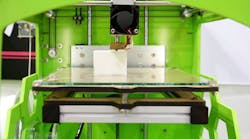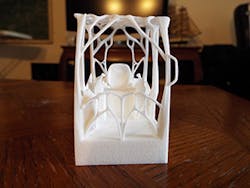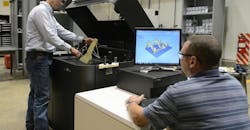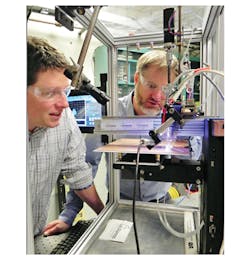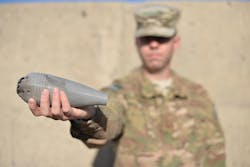Our previous installment discussed how 3D printing is having a significant impact on education, healthcare, and humanitarian relief. Continuing on, let’s examine how the process is helping to reduce pollution, as well as to protect soldiers and civilians from explosives.
The Environment
Shipping and logistics
Part 1 detailed how 3D printing will reduce the shipping and logistics of pills and humanitarian relief, but this trend looks like it is going to become a lot bigger. Ing, the bank and financial service corporation, predicts that printing could cut trade between countries by 40%: “For now it has very little effect on cross-border trade. This will change once high speed 3D printing makes mass production with 3D printers economically viable. The first technical steps have already been taken…3D printers use far less labor, reducing the need to import intermediate and final goods from low wage countries.”
Admitting that it is tricky to define the exact potential of 3D printing, ing said some experts expect a share of 50% in manufacturing over the next two decades. Depending on growth and investment the report suggested that 50% of manufactured goods will be printed by 2060 with current investment growth. This figure could possibly be achieved as early as 2040 if investments double every five years.
A large sector will be aftermarket parts for vehicles. As printing advances, car, truck, tractor, and motorcycle parts could be e-mailed or downloaded, and printed out at a parts store or mechanic’s shop. All of this brings obvious energy savings.
More efficient travel
For things that still have to move, like people getting to work, 3D printing is reducing the energy needed to get there. By printing multiple parts in one printed piece fasteners and weight can be reduced. With new printing technologies increasing speeds and reducing cost, designer are able to invest into a deeper or more radical designs impossible with traditional processes.
Students designed this scale cab of an excavator to win a design contest by Oak Ridge National Laboratory. This model will be 3D printed for a full-size 3D printing excavator at the 2017 CONEXPO-CON. Topographical optimization was among the design features that helped the students achieve the victory.
Currently, weight is reduced by adjusting a part’s infill, reducing extraneous material that would be too difficult to remove by traditional means, and reducing parts. As designers become more comfortable, they may start taking a more radical approach. With software and 3D printing designers might chose to take advantage of topology optimization (TO). It is a simulation tool in modern CAD software designed to help create a near-optimized part.
The simulation methods vary from software to software—it can be an additive or subtractive process. Some chisel away at the old design, removing material that is not crucial to strength or structure. Others grow parts from scratch until the design has reached an optimal structure. Solidworks, for example, uses the subtractive process implementing the Tosca optimization engine. “We felt the subtractive method was most attractive to our customers…with existing geometry you want to refine,” said Stephen Endersby, the company’s director of product portfolio management. “With Tosca, we also have the technology that has a track record in-house. So, it was a good, safe solution for our users.”
TO is virtually impossible to manufacture with traditional methods, but 3D printing has the potential to handle complex geometries in a minimal waste process with lightweight materials.
Reducing weight saves on fuel cost and the pollution that would have been generated by burning it. Companies might not be concerned with the reduction in pollution, but saving weight greatly decreases fuel cost. In addition, it can give electric vehicles longer range, helping to curb CAFE regulations.
Reducing cost is accelerating 3D printing in the aerospace industry, too. GE, for example, is planning to mass-produce 25,000 LEAP engine nozzles with 3D printing. According to a ReportsnReports study, “The Global Aerospace 3D Printing Market to Grow at 55.85% CAGR during the period 2016–2020,” the primary driver of 3D printing in the aerospace market is the miniaturization of jet engines. So not only is 3D printing reducing weight or parts, but also its physical size.
If 3D printing is able to reduce the need for resources by using less, and open access to technology without the need of logistics, could there be a reduction in the tension that comes from a lack of or access to these resources?
War
Reducing materials may not be much of an interest to military tanks or armored machines, but the military is using 3D printing in many different ways. In the Pantex Plant, a federal nuclear weapons facility in Amarillo, Tex., security is obviously important when handling explosives. And if the importance of safety increases with the size of the potential explosion, nuclear weapons have no room for error.
Nuclear safety
The Additive Manufacturing team has ventured into topology optimization in an effort to create stronger tools with less material. Existing designs are evaluated and anything nonessential is eliminated. The process is expected to not only save money, but also to increase safety margins.
Mechanical engineer Jason Jeffers and Tek Ferguson use a mathematical approach to design better fixtures using less material.
An example of a component recently selected for topology optimization is a fixture for the B61-12, America’s most sophisticated nuclear weapon. The B61-12 is currently undergoing a Life Extension Program (LEP) that will replace aging components and assess future weapon performance.
To ensure LEP success, the B61-12 was selected for the additive manufacturing for critical tooling project to identify possible improvements over the current conventional manufacturing methods, and multiple fasteners used to assemble individual fabricated components. By using the topology optimization approach, the additive manufacturing team was able to develop a new version of the fixture that exceeds the performance of its predecessor, significantly reducing the associated manufacturing costs, weight, and time.
Just one of many additive manufacturing success stories at Pantex involves a recent partnership between the additive manufacturing team and the High Explosives Manufacturing department. For years, the latter department relied on a disposable holding fixture to keep high explosives in place during the testing process. Made of glue, acrylic, and a special pad that alone cost more than $30, the fixture was expensive, time-consuming to assemble, and inadequate for the department’s needs.
The additive manufacturing team found a solution by creating a new, one-piece holding fixture through additive manufacturing. The updated fixture is reusable and eliminates the need for pads and glue, thus saving the department more than $300,000 and thousands of work hours every year.
Military models
3D printing is blowing up in the explosives industry. Not only are universities and research centers 3D printing TNT and thermite, but the military is printing model of explosive to practices shooting at them. Yes, you heard right—the U.S. military practices shooting at bombs.
Los Alamos chemists Bryce Tappan (left) and Alex Mueller (right) watch as the Hyrel System 30M 3D printer produces a little cone of mock explosive material. The process allows custom tailoring of internal structures that was not previously possible.
It is possible to disarm an explosive by shooting out the fuse! Models of bombs can be printed and used as targets. The custom model, made with traditional processes, was expensive. The cost could have limited training, but 3D printing these bomb models has alleviated this concern.
Printing bombs
Shooting a steel slug through the fuse of some bombs will render it a paperweight. A custom model of these bombs originally cost $100 each. While this sounds expensive, it is imperative these models are accurate. Now, though, the military can train more extensively because 3D printing them costs $5.
Bombs are also being printed. A paper from the Los Alamos National Laboratory details how Alex Mueller is leading a team to create the next-generation of explosives using 3D printing. By examining the microstructure and manipulating internal hollow spaces of TNT, the scientists are trying to control and tailor a new form of explosives.
Making an explosive more difficult to detonate when there’s an accident also makes it more difficult to detonate intentionally. The behavior of explosives such as TNT is largely controlled through hot spots. Introducing inclusions, such as air bubbles, into TNT will trap air inside, causing it to compress and rapidly heat up. The uneven flow into and around these bubbles results in points of intense heat called hot spots. These hot spots largely control the energy necessary to initiate detonation in TNT and other high explosives.
This is where 3D printing is disrupting explosives. With the ability to control material, and voids, Mueller’s team looks to control the release of energy through a sophisticated arrangement of hot spots.
“The ability to tailor sensitivity and the resultant energy release in the chemical reaction zone would be a holy grail in detonation physics research,” says Dana Dattelbaum, a Los Alamos detonation expert. “Control and manipulation of structures at the microscopic scales through 3D printing is an exciting step toward achieving these goals.”
Explosive containers and parts
So the military is printing models of bombs, and bombs themselves, and the Explosive Ordnance Disposal (EOD) Marines are custom printing the containers for explosives to go into. Explosives can be used in many ways. The problem is mixing the materials in differing amounts to match the size of the explosion desired.
The Explosive Ordnance Disposal (EOD) Marines tested 3D-printed small containers to be printed to just the right size needed to do the job. By 3D printing the containers they can minimize the amount of containers and parts they need to ship to a base or carry in the field. Using 3D printing for military purposes is so handy, they are already deployed in multiple active combat zones to be used as mini-factories for military applications.
This technology can carry over to civilian life in the form on airbags and other technologies that are helping make soldiers and civilians safer.
3D printing has been around since the 1980s, but researchers are still finding ways to use this process. Today 3D printing is helping to tackle some of our biggest problems. From reducing pollution to making safer explosives, we are just scratching the surface of how 3D printing can be used to make the world a better place.
